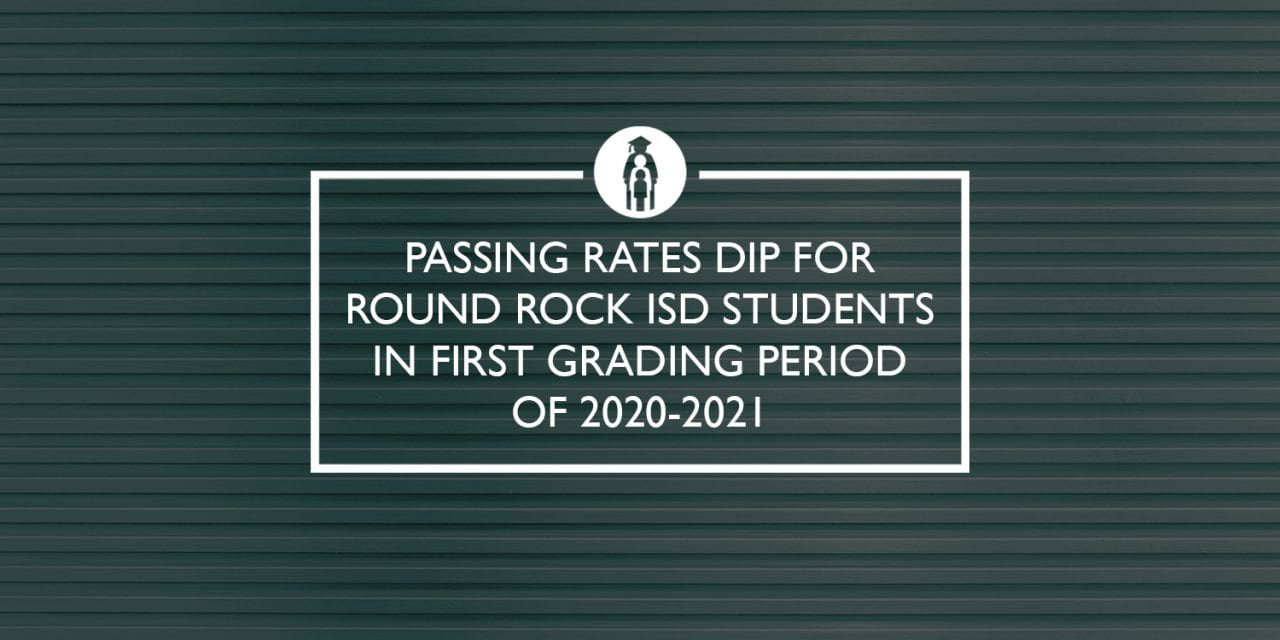Like districts across the state and around the country, Round Rock ISD is experiencing higher failure rates this year as students and educators adjust to new learning environments and work to overcome the major disruption caused by COVID-19.
Round Rock ISD’s Board of Trustees will meet Thursday to review and discuss the data and how District and campus administrators are using innovative tactics and highly-focused engagement strategies to help students bounce back.
At the high school level, 27 percent of students scored a grade below 70 in at least one class at the end of the first nine-week grading period, compared to 15 percent at the same time last school year. In middle school, the increase is sharper with 23 percent of students scoring below 70 in at least one class this year, compared to 8 percent last year. Students have the opportunity to improve these grades with repair and recover opportunities.
“Now more than ever we are promoting grace over grades, for both our teachers and students, providing teachers additional time to turn grades in and offering students multiple opportunities to improve their grades and turn in missing assignments,” Superintendent Steve Flores. Ph.D. said. “Students are learning in a new environment, on an unfamiliar platform and during a time of upheaval and uncertainty. We knew the inevitability that grades would be affected. Now, we must employ new strategies to repair learning loss and help our students continue to grow academically.”
Of all classes taken during the first nine-week grading period, middle school students passed 88 percent and high school students passed 89 percent with a 70 or above. Round Rock ISD Chief of Teaching and Learning Mandy Estes said all of the information from the first nine-week grading period is valuable formative data to guide instruction.
“We are facing the same challenges schools everywhere are dealing with, and we know districts across Texas are reporting significantly lower passing rates in the first grading period this year compared to last year,” Estes said. “Campuses are working diligently to reach out to struggling students with intervention strategies and additional support. We are confident that as students and teachers become more familiar with the learning platform, grades will improve.”
Comparisons to last year are more difficult to make at the elementary level, but according to benchmark testing, the overall percentage of students identified as on level in reading was slightly higher in kindergarten, approximately the same in first and second grades (within 2 percentage points) and lower at third, fourth and fifth grades. In kindergarten 76 percent tested on level while first and second graders tested 62 and 72 percent on level, respectively.
The District used a different test this year, so the comparison to last year is not apples-to-apples. In recent school years, the District used aimswebPlus as the universal reading screener in kindergarten through fifth grade, but this year needed a platform that could be made available to both on campus and at home learners. The District selected the iStation Indicators of Progress (ISIP) as its beginning-of-year screener because it is a computer adaptive test that can be taken independently by students across learning locations.
Both aimswebPlus and ISIP are valid and reliable measures of student reading achievement, are designed to show progress over the course of the school year, and are predictive of later performance on state assessments. However, because they are not precise equivalents, year-to-year comparisons should be interpreted with caution.
In third grade, 69 percent of students tested on level in reading this year on the ISIP, compared to 81 percent last year on aimswebPlus. In fourth grade, 74 percent tested on level this year and 86 percent were on level last year, and in fifth grade those numbers were 75 percent compared to 88 percent.
Teacher teams use the results of reading screeners as an indicator of which students might be at risk of reading difficulty, however, they are just one indicator of need. Additional assessments and student work are reviewed before determining the type and degree of support or intervention students may require.
For math assessment, Dreambox, a computer adaptive text, was used this year while aimswebPlus was used last year. Across most grades, there was little difference in the percentage of students scoring on level this year compared to last year. At kindergarten, first and third grade, more students scored on level this year than last:
- Kindergarten: 89 percent scored on level in 2020 compared to 71 percent in 2019.
- First Grade: 75 percent scored on level in 2020 compared to 65 percent in 2019.
- Third Grade: 86 percent scored on level in 2020 compared to 80 percent in 2019.
Second and fourth graders scored nearly the same (within 2 percentage points) as last year, with 76 percent of second-graders and 83 percent of fourth graders on level. Fifth graders saw a decline with 76 percent on level this year compared to 88 last year.
Campus teams, with District support, are using all of this data at the student level to design and deliver targeted support.
“Data is our most valuable resource to help guide our instructional decisions as we navigate these challenging and unprecedented circumstances,” Flores said. “We know the absolute best learning environment for the vast majority of our students is face-to-face instruction, but we also know many of our students will remain virtual for quite some time — some may prefer it and want to maintain it — so we must, and we will, create the best virtual learning experience for those students and ensure they have every opportunity to succeed just as they would have in a physical classroom setting.”

